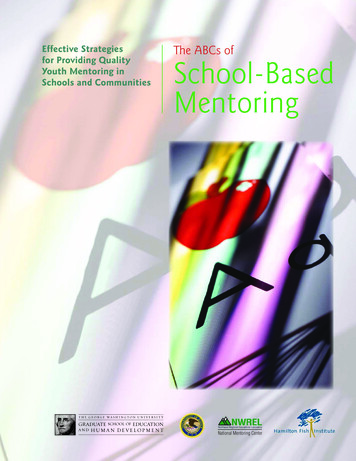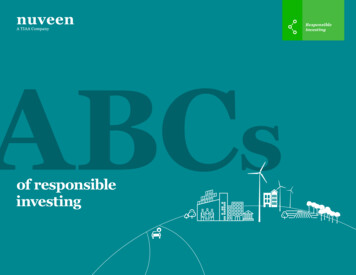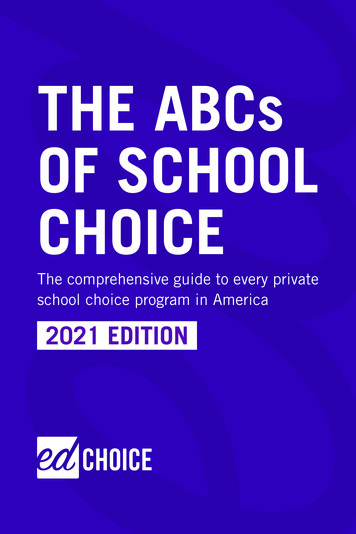
Transcription
Effective Strategiesfor Providing QualityYouth Mentoring inSchools and CommunitiesThe ABCs ofSchool-BasedMentoringNational Mentoring Center
This publication contains pages that have beenleft intentionally blank for proper paginationwhen printing.
TheABCs of SchoolEffective Strategies for Providing QualityBased MentoringYouth Mentoring in Schools and CommunitiesRevised September 2007Published by:The Hamilton Fish Institute on School and Community Violence &The National Mentoring Center at Northwest Regional Educational LaboratoryWith support from:Office of Juvenile Justice and Delinquency Prevention,U.S. Department of Justice
Hamilton Fish Institute on School and Community ViolenceThe George Washington University2121 K Street NW, Suite 200, Washington, DC 20037-1830Ph: (202) 496-2200E-mail: hamfish@gwu.eduWeb: http://www.hamfish.orgHamilton Fish Institute Director:Dr. Beverly Caffee GlennNational Mentoring CenterNorthwest Regional Educational Laboratory101 SW Main St., Suite 500Portland, OR 97204Toll-free number: 1-800-547-6339, ext. 135E-mail: mentorcenter@nwrel.orgWeb: http://www.nwrel.org/mentoringNational Mentoring Center:Eve McDermott, DirectorAuthors:Original edition—Linda JucovyRevised content—Michael GarringerEditors:Michael Garringer and Patti MacRaeTechnical editor:Eugenia Cooper PotterLayout design:Dennis WakelandCover design:Paula Surmann 2008, National Mentoring CenterAll Rights ReservedThis project was supported by the Hamilton Fish Institute on School andCommunity Violence through Award No. 2005-JL-FX-0157 awarded by theOffice of Juvenile Justice and Delinquency Prevention, Office of Justice Programs,U.S. Department of Justice. Points of view or opinions in this document arethose of the author and do not necessarily represent the official position orpolicies of the U.S. Department of Justice or the Hamilton Fish Institute.
About the Effective Strategies forProviding Quality Youth Mentoring inSchools and Communities SeriesMentoring is an increasingly popular way of providing guidance and support to young people in need. Recent years have seen youth mentoringexpand from a relatively small youth intervention (usually for youth fromsingle-parent homes) to a cornerstone youth service that is being implemented in schools, community centers, faith institutions, school-to-workprograms, and a wide variety of other youth-serving institutions.While almost any child can benefit from the magic of mentoring, thosewho design and implement mentoring programs also need guidance andsupport. Running an effective mentoring program is not easy, and thereare many nuances and programmatic details that can have a big impacton outcomes for youth. Recent mentoring research even indicates thata short-lived, less-than-positive mentoring relationship (a hallmark ofprograms that are not well designed) can actually have a negative impacton participating youth. Mentoring is very much worth doing, but it is imperative that programs implement proven, research-based best practicesif they are to achieve their desired outcomes. That’s where this series ofpublications can help.The Effective Strategies for Providing Quality Youth Mentoring in Schoolsand Communities series, sponsored by the Hamilton Fish Institute onSchool and Community Violence, is designed to give practitioners a setof tools and ideas that they can use to build quality mentoring programs.Each title in the series is based on research (primarily from the esteemedPublic/Private Ventures) and observed best practices from the field ofmentoring, resulting in a collection of proven strategies, techniques, andprogram structures. Revised and updated by the National Mentoring Center at the Northwest Regional Educational Laboratory, each book in thisseries provides insight into a critical area of mentor program development:Foundations of Successful Youth Mentoring—This title offers a comprehensive overview of the characteristics of successful youth mentoring programs. Originally designed for a community-based model, its advice andplanning tools can be adapted for use in other settings.iii
Generic Mentoring Program Policy and Procedure Manual—Much of thesuccess of a mentoring program is dependent on the structure and consistency of service delivery, and this guide provides advice and a customizable template for creating an operations manual for a local mentoringprogram.Training New Mentors—All mentors need thorough training if they are topossess the skills, attitudes, and activity ideas needed to effectively mentor a young person. This guide provides ready-to-use training modules foryour program.The ABCs of School-Based Mentoring—This guide explores the nuances ofbuilding a program in a school setting.Building Relationships: A Guide for New Mentors—This resource is written directly for mentors, providing them with 10 simple rules for being asuccessful mentor and quotes from actual volunteers and youth on whatthey have learned from the mentoring experience.Sustainability Planning and Resource Development for Youth MentoringPrograms—Mentoring programs must plan effectively for their sustainability if they are to provide services for the long run in their community.This guide explores key planning and fundraising strategies specifically foryouth mentoring programs. The Hamilton Fish Institute and the National Mentoring Center hope thatthe guides in this series help you and your program’s stakeholders designeffective, sustainable mentoring services that can bring positive directionand change to the young people you serve.iv
AcknowledgmentsThe original The ABCs of School-Based Mentoring was written byLinda Jucovy, who thanks a number of people who made valuablecontributions to that earlier version:Carla Herrera, of Public/Private Ventures (P/PV), who contributedideas and information, shared numerous materials, and provideddetailed feedback on an earlier draft.Jean Grossman, also at P/PV, who managed the project and offeredessential support and feedback.Susan Weinberger of the Mentor Consulting Group who, whilenot directly involved with this project, has been an ongoingsource of insight into the special rewards and challenges ofschool-based mentoring programs.This new revised version builds upon Linda’s original by includinginnovative and up-to-date research findings, most notably from the newP/PV research report: Making a Difference in Schools: The Big BrothersBig Sisters School-Based Mentoring Impact Study. The National MentoringCenter thanks Carla Herrera, Chelsea Farley, and Linda Jucovy of P/PVfor their insights and recommendations on the revised material. We alsothank Big Brothers Big Sisters of America (BBBS) for their contributionsto the original publication and for allowing others to learn from ongoingresearch into their successful practices.The NMC also thanks Scott Peterson at the Office of Juvenile Justiceand Delinquency Prevention, U.S. Department of Justice, for his ongoingsupport of the NMC and for youth mentoring in general. Finally, wethank the Hamilton Fish Institute on School and Community Violence atthe George Washington University for their support in developing anddisseminating this revised publication.v
blank page
ContentsIntroduction . . . . . . . . . . . . . . . . . . . . . . . . .What Is School-Based Mentoring? . . . . . . . . . . . . . . . . .What Are the Benefits of a School-Based Mentoring Model? . . . .What Are the Drawbacks of a School-Based Mentoring Model? . . .1.3.4.6Section 1. Planning a School-Based Mentoring Program . . .Get Buy-in at the Highest Levels of School Leadership . . . . . . .Determine the Scope and Structure of the Program . . . . . . . . .Determine Roles and Responsibilities . . . . . . . . . . . . . . . .Write It Down! . . . . . . . . . . . . . . . . . . . . . . . . . . .9.9131821Section II. Mentor Program Basics . . . . . . .Student Referral. . . . . . . . . . . . . . . . . . .Mentor Recruitment . . . . . . . . . . . . . . . .Participant Screening . . . . . . . . . . . . . . . .Participant Training . . . . . . . . . . . . . . . . .Making Matches . . . . . . . . . . . . . . . . . .Match Supervision and Support . . . . . . . . . .The End of the School Year and Match Closure . . .Program Evaluation . . . . . . . . . . . . . . . . .252526313337424751. . . . . . . . . . . . . . . . . . . . . . . . . . . . . . . . . . . .Conclusion . . . . . . . . . . . . . . . . . . . . . . . . . . 53Sample Forms. . . . . . . . . . . . . . . . . . . . . . . . . 55References . . . . . . . . . . . . . . . . . . . . . . . . . . 71Additional Reading and Resources . . . . . . . . . . . . . . 73vii
The ABCs of School-Based Mentoring“I’m more a brother or afriend, I guess, than a parent oranything. That’s the way I try toact and be with him. I don’t wanthim to think—and I don’t think hedoes—that I’m like a teacher or aparent or something. . . . I don’twant him to be uncomfortable, likeI’m going to be there always looking over his shoulder and alwaysthere to report him for things hedoes wrong and that he tells me. Ijust want to be there as his friendto help him out.”—Mentor, Minneapolisviii
IntroductionThe program director and I used to talk about what was wrongwith the world, and we always used to say that if somebodycould just hold these kids’ hands sometimes—not drag themalong, but just walk along with them—maybe a lot of themwould find their way.— Mentor, Washington, D.C.Both research and common sense leave little doubt thatyouth need caring and consistent relationships withadults in order to navigate their way through adolescenceand beyond. For many youth, however, there is no adult whois naturally available to provide this kind of support. To fillthis void, there has been an increase in formal mentoringprograms, most prominently in community-based settings.These community-based programs have shown the abilityto improve youth behaviors and attitudes. Evaluation resultsprovide clear evidence that involvement in consistent, longterm, well-supervised relationships with adults can yield awide range of tangible benefits for youth, including improvedgrades and family relationships and decreased alcohol anddrug use (Sipe, 1996; Tierney & Grossman, 2000).Given these positive outcomes for youth, and the enormousnumber of young people who might benefit from the supportof a caring adult, youth-serving organizations are eager toimplement new mentoring programs or expand their currentones. To complement the traditional community-based model—where mentors and youth decide where and when theywill meet—organizations are increasingly looking to schoolbased programs as a strategy for spreading the impact of mentoring.The following material provides practical information for youth-servingorganizations that want to implement a new school-based mentoringprogram or strengthen an existing one. Drawing on recent research andpromising practices developed by organizations around the country,this guide leads readers through the process of planning and imple-1
The ABCs of School-Based Mentoringmenting a quality school-based mentoring program. It also includesworksheets to help guide planning, sample forms that programs canadapt and use, and a list of additional resources.This guide is designed primarily for mentoring organizations who wishto partner with a school or school district to provide adult-youthmentoring services on campus. Much of the content addresses how tostructure roles and responsibilities for each party and how to structureservices so that the partnership functions effectively. The content canalso be adapted by:Schools or districts that wish to design and staff their ownstand-alone mentoring programs.Programs that wish to implement an older student–youngerstudent model, as much of the research that has informed thisguide examined peer mentoring models in school settings, inaddition to the more traditional adult-youth structure.Building on New School-Based Mentoring ResearchResearchers are learning more about what constitutes an effective school-based mentoring program and by analyzing successful program structures and outcomes, they are clarifying the bestpractices and promising approaches that other mentoring programs can adopt. The advice provided in this guide has been greatly enhanced by the research findings provided in Public/Private Venture’s 2007 report Making a Difference in Schools: The Big Brothers Big Sisters SchoolBased Mentoring Impact Study. This research report studied 10 Big Brothers Big Sisters (BBBS)school-based mentoring programs to find out what techniques they were using to producesuccessful results, while also examining the challenges and barriers they faced in implementingservices and fully achieving program goals.The full research report, a must-read for anyone planning a new school-based mentoring program,is available for download from the P/PV Web site at: http://www.ppv.org2
IntroductionWhat Is School-Based Mentoring?School-based mentoring is defined by many program features thatcontrast it to community-based mentoring models. Among the key elements frequently found in school-based mentoring programs:1. The program operates on the school campus. Whetherthe result of a school-community partnership or developed as astand-alone school service, school-based mentoring programsare usually housed at the school site, with adults and youthmeeting in various campus locations and the program makinguse of school facilities and administrative space.2. Mentoring relationships meet for the duration of theschool year. However, there is compelling recent evidence thatprograms should make every effort to extend mentoring relationships throughout the summer months and across gradesto improve the outcomes for youth (Herrera, Grossman, Kauh,Feldman, & McMaken, 2007). More information about the valueof multi-year school-based mentoring follows in the “Planning aSchool-Based Mentoring Program” section of this guide.3. Youth are referred by teachers, counselors, and otherschool staff. While some programs do allow parents torequest a mentor, most school-based programs are built aroundthe concept of school personnel initiating youth participation inthe program.4. School-based mentoring is not simply a tutoring program, nor is it as unstructured as community-basedmentoring. Most school-based programs reside somewherein between these two models. Mentoring matches are encouraged to view the development of a trusting, mutually satisfyingrelationship as the primary goal of their time spent together.However, because of the campus setting and the inherent connection to academics and the school itself, these matches aremore structured than those typically found in purely community-based models. Restricted to the campus setting, matchesare encouraged to engage in some structured activities, oftenaround classroom- or homework-related topics.3
The ABCs of School-Based MentoringWhat Are the Benefits of a SchoolBased Mentoring Model?There are many compelling reasons for schools and mentoring organizations to partner in developing a school-based mentoring model:1. Engaging volunteers and youth who might not beinvolved with mentoring otherwise. In one study, abouthalf of school-based mentors reported they would not haveconsidered community-based mentoring opportunities (Herrera,2004). Because school-based programs require a shorter andless intensive time commitment than traditional communitybased programs, they can attract categories of volunteers—such as corporate employees, college students, and militarypersonnel—with limited amounts of free time. Because thementor-student meetings take place in the relative security ofschools, the programs are also attractive to older adults andothers who may be concerned about having to spend time witha youth out in the community. Additionally, programs thatadopt a peer mentoring model are able to involve older youthas mentors. Because of greater ability to monitor and guidematches, school-based programs may be a better fit for highschool-aged mentors. Because of these differences, schoolbased mentoring can easily expand the volunteer pool of acommunity-based program.These programs also reach youth who might be underserved bythe traditional community model, which places an emphasis onlong-term relationship development and intensive role modeling. School-based mentoring, with its on-campus location andblend of academic activities and friendship, can perhaps bestserve youth who simply need some extra attention and supportat school. The fact that teachers and school staff, not parents,refer youth to the program also contributes to school-basedmentoring’s ability to reach youth who may not be served intraditional community-based models.Both school- and community-based models have inherentvalue, and the presence of one does not reduce the need forthe other. As one prominent research report put it, “differentchildren and communities have different needs that neitheroption can fully address alone . . . using both strategies is likelythe best way for programs and funders to reach a wide, diversegroup of youth and volunteers” (Herrera et al., 2007).2. School-based mentoring can be operated at a fairly lowcost. Because most school-based mentoring programs makeuse of school facilities and resources, they can be operated at4
Introductionfairly low cost. One research report found an average programcost of 1,000 per youth served, with 900 of that being budgeted by the program and 100 coming in the form of donatedgoods and services from the school and others. These costs peryouth were slightly lower than the community-based mentoringmodel offered by the same agencies (Herrera et al., 2007).3. There is compelling evidence that school-based mentoringproduces many positive outcomes for youth. Recent researchinto school-based mentoring outcomes indicates that theseprograms can:Improve academic performance, in general, withsignificant improvements demonstrated in the subjectsof science and written and oral languageImprove the quality of class workIncrease the number of homework and in-classassignments turned inReduce serious school infractions, such as disciplinaryreferrals, fighting, and suspensionsIncrease students’ perceptions of scholastic competenceReduce skipping classesThis research also indicates that youth participating in schoolbased mentoring programs are more likely than non-mentoredpeers to report having a non-parental adult who “they lookup to and talk to about personal problems, who cares aboutwhat happens to them and influences the choices they make”(Herrera et al., 2007).Additional research into school-based mentoring outcomesfound that mentored students developed more positive attitudes toward school, were more likely to trust their teachers,and developed higher levels of self-confidence and a greater ability to express their feelings (Curtis & Hansen-Schwoebel, 1999;Karcher, 2005; Karcher, Davis, & Powell, 2002).Programs that use older (typically high school) youth as mentorsalso have the added benefit of producing positive outcomes forthose students as well, although current research is unclear onthe types or degrees of outcomes peer mentors might receive.5
The ABCs of School-Based MentoringWhat Are the Drawbacks of a SchoolBased Mentoring Model?While school-based mentoring has many tangible outcomes, there aresome aspects of this model that program planners need to consider:1. School-based mentoring may have little impact onout-of-school-time issues. The most recent research onthe school-based model found no impact on such non-schoolrelated issues as drug or alcohol use, stealing and other misconduct outside of school, self-worth, and relationships withparents and peers (Herrera et al., 2007). However, earlier, nonexperimental evaluations of school-based programs have foundevidence of positive benefits in some out-of-school areas, suchas increased self-esteem and connectedness to parents (Karcher,2005). While future research may demonstrate a connectionbetween school-based mentoring and out-of-school behaviors,for now practitioners should note that the primary benefitsappear to be in the school-related areas described above.2. School-based mentoring programs, on average, do notproduce relationships with the same closeness andquality as community-based programs. With restrictedactivity options, gaps in meeting times during the summerand holiday breaks, and a potential lack of private space formatches to meet in, school-based programs may not be able tobuild the types of close, mutual relationships that communitybased mentoring programs can produce. Researchers have longpointed to relationship closeness and duration as key predictorsof mentoring outcomes, and the on-campus structure of schoolbased programs may simply not provide sufficient adult-youthtime together or a wide enough variety of activities to achievethe level of relationship closeness found in successful community-based programs.Additionally, the use of high school students as mentors inschool-based programs indicates that some youth may notreceive the purely adult role modeling and guidance seen intypical community-based programs. So, while school-basedmentoring produces many positive outcomes, on average, itmay not provide the same type or intensity of support found inother mentoring models.3. School-based mentoring programs often struggle tofind their proper place in the school environment. It canbe difficult for school-based mentoring programs to foster theunderstanding and level of commitment required to operate a6
Introductionsuccessful program at the school site. Oftentimes, school-basedprograms are incorrectly perceived as a tutoring service, whosegoal is to boost grades or provide narrow academic support.On-campus programs may also have difficulty garnering thesupport of administrators, teachers, and other school personnelwho view the program as one more item to add to their alreadyfull list of responsibilities. It can also be difficult for schoolbased programs to find ongoing funding for the program withinthe context of shrinking school budgets and extreme competition for funds.Existing mentoring programs looking to partner with schoolsmust create a deep sense of commitment and understandingabout the goals, scope, and implementation of services amongall school stakeholders. More details about creating this understanding follow in the next section of this guide.In spite of some inherent challenges, school-based mentoring is aninnovative supplement to the traditional learning that takes place inschools, providing potentially underserved students with another avenue through which they might feel more confident about their schoolwork, improve their attitudes and commitment to learning, and developmore fully as a person. The rest of this guide explores how to develop aschool-based mentoring program and the many components that canlead to successful youth outcomes.7
The ABCs of School-Based Mentoring“The main thing at firstwas just gaining trust—that trustthat she would confide to me.That was important first. I had tolet her know that no matter what,she could tell me anything and I’dbelieve her and trust her and I’dsupport her. I think that’s whatthese kids need. . . . I think it justtakes a long time to build up atrust.”—Mentor, Columbus, Ohio8
Section I.Planning a SchoolBased MentoringProgramYou have to build relationships first. You can’t just walk intopeople’s offices and tell them what to do.— Program Director, San Antonio, TexasThere are several key steps to developing a successful school-based mentoring program. While everyschool and community is unique, there are some common elements of program planning that will position anew program for long-term success:Get Buy-in at the HighestLevels of School LeadershipThe success of any on-campus program rests on the commitmentianddleadership of the principal and other administrators. These individualsare instrumental in securing funds and facilities for the program and forgetting the support of teachers, counselors, coaches, and other staffmembers who will help implement or enhance the services provided.It might also be useful to get the backing of leadership at the districtor school cluster level, especially if the program is to be replicated ifproven successful.You may also seek the specific support of school councils (which sometimes have management responsibility over a school site) and any parent groups that have a strong influence in decision making.You can win the support of these key parties by:Finding a “champion.” During your early meetings at the district level or with individual schools, identify a key supporter—9
The ABCs of School-Based Mentoringsomeone respected in the schools—who will help promote theprogram to other school personnel. In some cases, your champion might also collaborate in planning the mentoring project.Showing how your program will help achieve existingeducational objectives. In forming any partnership, you wantto focus first on your partner’s interests. Before approaching theschool district or an individual school, identify the ways yourmentoring program can contribute to existing educational plansor priorities. Use research findings to demonstrate the effectsthat mentoring can have on student attendance, attitudes,behavior, and grades.Bringing other community partners to the table. Determine if any local businesses or service organizations have anAdopt-a-School program and are looking for someone to helpthem get their program focused and implemented. They can helpbuild momentum for the program—and provide an immediatesource of potential mentors.Being alert to potential “turf” issues. As you plan theprogram, these could include conflicting work styles and different “languages” or professional jargon that interferes with goodcommunication. There may also be turf concerns about programoperations, such as the use of space in the school and use ofequipment like copying machines and computers. There couldalso be potential turf issues with other outside programs thatare operating in the school. Thus, it is important to find outwhat other programs are in the school so you can communicatewith their staff early and avoid problems.Once you get initial buy-in from your school’s key groups, you shouldform an advisory committee or other oversight group that can plan theinitial goals, structure, and implementation of the program, as well asprovide guidance for the long term. This group should be composed ofthe principal (or other designated administrators), staff from the mentoring agency, teachers, counselors, parents, students, and representatives from any community and business partners. This diverse groupwill ensure that all stakeholders are represented when key decisions aremade about the program and can provide valuable support when maintaining, expanding, or replicating the program over time.See the following page for additional tips on forming and maintainingeffective partnerships with schools. Worksheet #1, on page 12, canhelp mentoring programs prepare to approach a school about a potential new partnership.10
Special Considerations for Working With SchoolsYou want your program—and your mentors—to be a strong and positive presence in the school. Accomplishing this requires an ongoing process of building and maintaining support from the school. There are twounderlying guidelines to always keep in mind: schools require a lot of structure in order to accomplish theirmission of educating children and youth, and they are always short on resources.Organizations that have experience working withschools recommend the following practices forstrengthening your partnership and your program’srole in the school:1. Know the school culture, policies, and procedures. Respect teachers’ time constraints andneed for structure and order. Develop a mentoring schedule that fits into the school-day structure. And obtain feedback from teachers andother school personnel early and often so youcan make any necessary adjustments.2. Be sure your mentors are aware of, and sensitive to, the school culture. Mentors shouldunderstand the procedures for using schoolproperty, honor the dress code, and understandwhether, when, and how to access teachers.They should also know if there are any “unwritten rules” governing the space where they aremeeting with the student. If, for example, theyare meeting in an empty classroom, what are theteacher’s “rules” about using any equipment ormaterials in the room?3. Understand that school staff and administrators may have had negative experienceswith previous outside programs. At times,well-meaning groups and individuals approachschools with the intention of working withthem, and then fail to follow through with, orfall short of, their original commitment. That,in turn, is likely to influence a school’s attitudetoward your mentoring program, and you maymeet with resistance from some staff and administrators until your program has proven its reliability and value.4. Be aware of the existence of other outsideprograms in the school. Be sure your mentoring program complements rather than duplicatesexisting programming. Being aware of and, wherepossible, collaborating with existing schoolbased programs makes it easier to integrate yourprogram into the school and is likely to enhanceyour value.5. Provide a staff presence from your programat the school as often as your resourcesallow. The person from your organization who isresponsible for the day-to-day operation of theprogram might be called a program administrator,coordinator, supervisor, or case manager. Whoever it is, that person should be a regular presence in the school, including during times whenteachers are free to have informal conversations.6. Remember that the program requires threeway communication among your
While almost any child can benefit from the magic of mentoring, those who design and implement mentoring programs also need guidance and support. Running an effective mentoring program is not easy, and there are many nuances and programmatic details that can have a big impact on outcomes for youth. Recent mentoring research even indicates that











